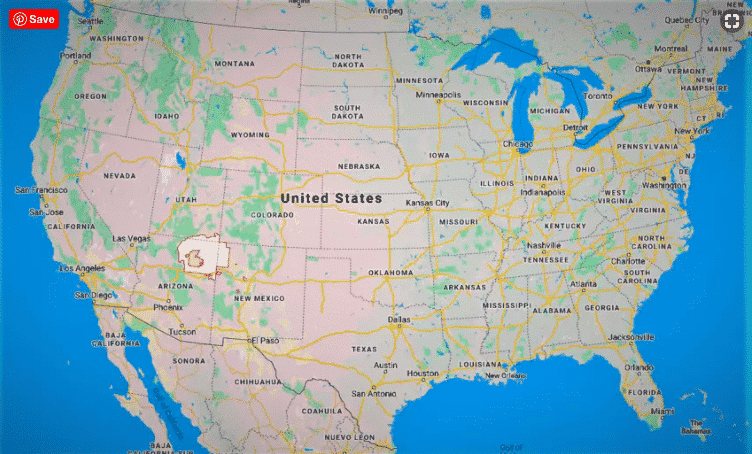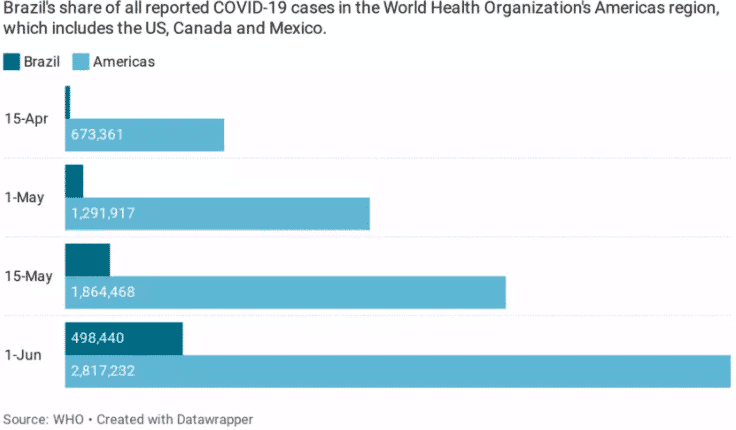

Indigenous people from the Parque das Tribos community mourn the death of Chief Messias of the Kokama tribe from Covid-19, in Manaus, Brazil, on May 14, 2020. MICHAEL DANTAS / AFP / Getty Images
By John Letzing
This past Wednesday, when some previously hard-hit countries were able to register daily COVID-19 infections in the single digits, the Navajo Nation – a 71,000 square-kilometer (27,000-square-mile) expanse of the western US – reported 54 new cases of what’s referred to locally as “Dikos Ntsaaígíí-19.”
That brought the total number of reported cases in the designated home of the Navajo people to 5,533, as the number of known deaths reached 252. For an area with an estimated population of 172,875, that translates into an infection rate more than five times that of the US as a whole. The Navajo Nation is not an isolated example. Around the world, COVID-19 still poses a disproportionate threat to indigenous communities even as it recedes elsewhere.
According to the United Nations, indigenous peoples’ traditional lifestyles can create greater risks of spreading infection when they involve large gatherings to mark events like harvests, or living in multi-generational housing with elderly family members. The indigenous also suffer from a relatively high degree of socio-economic marginalization that makes them more vulnerable. This dynamic is not new.
The Navajo Nation government issued a stay-at-home order as COVID-19 spread, implemented a curfew, and mandated the use of masks in public. But it has struggled with issues including the fact that nearly a third of the homes in the area (detailed in the map below) lack running water for hand washing.

The Navajo Nation covers the corners of three different states. Google Maps
In Brazil, an advocacy group reported last month that the COVID-19 mortality rate among indigenous people was nearly twice that of the country as a whole. Prior to that, a mapping service had published an analysis showing that villages in the Amazon are on average 315 kilometers (195 miles) away from the nearest intensive care bed in the Brazilian public health system – and more than half of the villages analyzed were more than 200 kilometers (124 miles) away from any intensive care unit.
Brazil is just one of the countries in the World Health Organization’s Americas region with significant and remote indigenous populations deemed vulnerable to the pandemic. The WHO said the region recently accounted for half of the 10 countries in the world reporting the highest new number of cases over a 24-hour span.
Growing Contribution

World Economic Forum
There are exceptions, however. Some of the world’s indigenous populations appear not to be overly impacted by COVID-19. In New Zealand, for example, the Māori accounted for 9% of reported cases as of 4 June, but represent more than 16% of the country’s population. And in Canada, government figures have not indicated an unusual infection rate for indigenous people – though there are concerns that indigenous cases in the country are being undercounted.
For more context, here are links to further reading from the World Economic Forum’s Strategic Intelligence platform:
- COVID-19 is not the only thing indigenous people in Brazil have to worry about. According to this report, indigenous lands in the country are being devastated as the outside world has been distracted by the pandemic. (The Conversation)
- Perhaps no community in North America has been more shaped by infectious disease than Native tribes, according to this report. (Christian Science Monitor)
- In Colombia, the killing of indigenous leaders increased after a coronavirus-related lockdown in March made them easier to locate in isolation, according to this report. (LSE)
- In some countries consultations with indigenous people are now being abruptly suspended in order to force through megaprojects relating to agribusiness, mining, dams and infrastructure, according to a UN independent expert. (Ecosystem Marketplace)
- Mining sites, deemed an essential business during the pandemic, are placing indigenous communities in Canada and several other countries at high risk of infection, according to this report. (YaleE360)
- The Secoya community fled by canoe to isolate themselves from the outbreak in the central wetlands of Lagarto Cocha in Ecuador, only to suffer 15 confirmed cases and two deaths among its population of 744, according to this report. (The New Humanitarian)
- Well ahead of government action, indigenous federations across the Amazon launched extensive campaigns to mitigate the pandemic and its socie-economic consequences, according to this report. (The Conversation)
On the Strategic Intelligence platform, you can find visualizations and feeds of expert analysis related to COVID-19, Global Health and hundreds of additional topics. You’ll need to register to view.
Reposted with permission from World Economic Forum.
- Black and Hispanic Americans Suffer Disproportionate Coronavirus ...
- Native American Tribes' Pandemic Response Is Hindered by ...
- Navajo Nation Has Highest Covid-19 Infection Rate in the U.S. ...
- Brazil Passes 50,000 Coronavirus Deaths as Global Cases Top 9 Million - EcoWatch
- Methane Pollution in Navajo Nation Found to Be Double the National Average

 233k
233k  41k
41k  Subscribe
Subscribe 